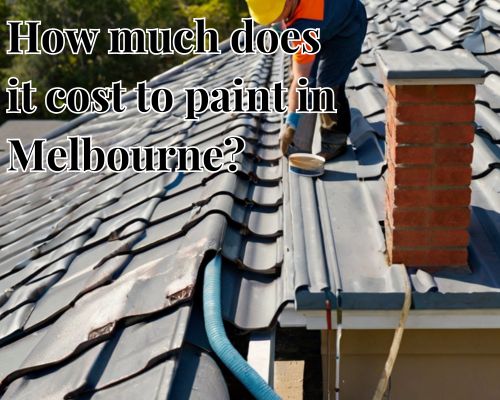How Much Does It Cost to Paint in Melbourne? A Comprehensive Guide
How Much Does It Cost to Paint in Melbourne? A Comprehensive Guide
Painting your home or commercial space in Melbourne can be a great way to refresh the aesthetic appeal, increase property value, and protect surfaces from wear and tear. However, before you begin your painting project, it is essential to understand the cost factors involved. With Steve Arnie of Gutter Cleaning Melbourne, we will provide a comprehensive breakdown of the costs associated with painting in Melbourne, Australia, covering key influences such as property size, labor, materials, and other important considerations.

Factors Affecting the Cost of Painting in Melbourne
Several factors influence the overall cost of a painting project in Melbourne, including:
1. Type of Property
The type of property being painted—whether it is a residential home, apartment, or commercial building—greatly affects the price.
- Residential Painting: A standard house painting job in Melbourne typically costs between $3,500 and $10,000 depending on the number of rooms and the overall square meterage.
- Apartment Painting: Costs range from $2,000 to $7,000, depending on the size and whether it’s a full repaint or just a refresh.
- Commercial Painting: Larger commercial buildings often require specialized coatings and more labor, leading to costs ranging from $5,000 to $50,000+, depending on the complexity of the job.
2. Interior vs. Exterior Painting
- Interior Painting: Typically ranges from $20 to $40 per square meter, depending on the type of finish and the number of coats required.
- Exterior Painting: Due to factors like weather exposure, scaffolding requirements, and surface preparation, exterior painting costs more, typically ranging from $30 to $60 per square meter.
3. Paint Quality and Materials
The choice of paint brand, finish, and durability greatly impacts the overall cost. Premium brands like Dulux, Taubmans, and Haymes offer high-quality finishes, with prices per liter ranging from $30 to $80. Low-VOC and eco-friendly paints may also add to the cost.
4. Labour Costs
Professional painters in Melbourne charge between $40 and $70 per hour, depending on experience and project complexity. Some companies charge per square meter instead, with labor costs averaging $15 to $45 per square meter.
5. Surface Preparation & Repairs
Before painting begins, walls and surfaces may need preparation, including:
- Patching holes and cracks
- Sanding and priming
- Removing old paint or wallpaper
- Cleaning mold or stains
Additional preparation work can add $200 to $2,000 to your total cost, depending on the extent of repairs required. For more, visit https://gutter-cleaning-melbourne.com.au/.
Cost Estimates for Different Painting Projects in Melbourne
To help you budget for your painting project, here’s an estimate based on different property types:
| Type of Painting Project | Average Cost in Melbourne |
|---|---|
| 1-Bedroom Apartment | $2,000 – $4,000 |
| 3-Bedroom House | $5,000 – $10,000 |
| 4+ Bedroom House | $8,000 – $15,000 |
| Exterior Painting | $5,000 – $20,000 |
| Commercial Painting | $10,000 – $50,000+ |
Additional Cost Considerations
1. Scaffolding & Access Equipment
For multi-story homes or high-rise buildings, scaffolding may be required, which can add $1,000 to $5,000 to your overall budget.
2. Lead Paint Removal
Older homes built before 1970 may contain lead-based paint, requiring specialized removal that can cost between $30 and $50 per square meter.
3. Special Finishes & Effects
Custom paint finishes, such as textured walls, Venetian plaster, or mural painting, may increase costs by 30% to 50%.
Tips for Saving Money on Painting in Melbourne
- Get Multiple Quotes: Always obtain at least three quotes from local Melbourne painters to compare pricing.
- Choose the Right Season: Summer and spring are peak seasons; consider painting during winter for better rates.
- Do Some Prep Work Yourself: Removing furniture, sanding, or patching minor holes can reduce labor costs.
- Opt for Mid-Range Paints: High-quality paints last longer but don’t always require premium pricing. Choosing a durable mid-range option can balance cost and quality.
- Bundle Services: If you need both interior and exterior painting, some painters offer discounts for full-house projects.
Finding the Right Painter in Melbourne
When choosing a painting professional, consider:
- Experience & Credentials: Look for painters with at least 5+ years of experience.
- Customer Reviews: Check Google Reviews and platforms like Hipages, ServiceSeeking, and Oneflare.
- Licensing & Insurance: Ensure the painter is licensed and carries public liability insurance.
- Warranty & Guarantee: Many reputable painters offer a 5 to 10-year workmanship guarantee.
Conclusion
The cost of painting in Melbourne varies widely depending on multiple factors, including the size of the property, labor costs, materials used, and preparation work required. Whether you are looking to freshen up your home’s interior, add curb appeal with an exterior repaint, or invest in a commercial paint job, understanding these costs will help you make an informed decision. By obtaining multiple quotes, choosing the right season, and selecting the best paint for your needs, you can achieve a high-quality finish that suits your budget.
If you’re searching for professional painters in Melbourne, consider reaching out to local painting contractors for a detailed consultation and quote. A fresh coat of paint not only enhances aesthetics but also adds long-term value to your property!
